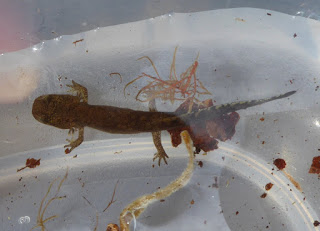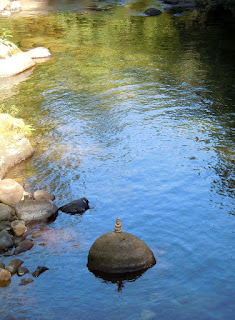 |
| Ensatina |
There were seven of us altogether, picking a delicate path through the forest duff, lifting stones and peeking under logs. Maybe the passing hikers mentally supplied their own crime-scene tape or something, but nobody asked us what we were up to.
What we were up to was looking for amphibians. There’s not a lot that can cheer me up as reliably as a good salamander, but I’ve gotten out of the habit of looking for them. I used to live back east, where every other rolled log would yield two or three glistening beauties, and when I moved out to this damp paradise I assumed I was entering salamander heaven, but I wasn’t. Not only were they scarce, but the few that were here blended together in my mind. No bright orange, no speckles, no red cheeks, no yellow dots to be found. Pacific Northwest salamanders run the gamut between dull brown and dull blotchy brown, and they’re shy, too. I gave up even looking.
 So when the local Audubon Society advertised a field trip for local amphibians, I signed up. Finally I’d be tagging along with an expert. It seemed challenging. The field guide likes to point out distinctions such as “third toe on hind foot slightly longer.” I figured the best I could do was be in a position to admire our amphibians without exactly knowing what name they answer to. That’s basically what I do with birds, actually.
So when the local Audubon Society advertised a field trip for local amphibians, I signed up. Finally I’d be tagging along with an expert. It seemed challenging. The field guide likes to point out distinctions such as “third toe on hind foot slightly longer.” I figured the best I could do was be in a position to admire our amphibians without exactly knowing what name they answer to. That’s basically what I do with birds, actually.
 |
| Dunn’s |
And it was challenging. All seven of us looked under everything in sight and we came up with only six critters all day long, representing only three species. But instead of having to settle for a marginal level of competence, I discovered that I have those three species totally nailed now. We learned the Dunn’s salamander has no lungs or gills and doesn’t breed in the water, so he was going to be under a flat stone in the mossy damp above the stream but not close enough to be in danger of drowning. We found two, both so hard-won that I won’t forget that the dingy mustard stripe on his back stopped short of the end of his tail, just as advertised. Dunn’s, nailed. And we knew the baby Coastal Giant salamanders are under rocks in the stream and they do have gills, and after we’d Tupperwared a few of them we could definitely see their heads are squarer than other salamanders’. Larval Giants, nailed. And there was a certain kind of barky, punky log that the Ensatinas favored: the little lovelies with the constrictions at the base of their tails and the orange armpits. Ensatinas, nailed. When you look for these guys this hard, you notice them hard too.
 |
| Larval Coastal Giant |
So it hasn’t been that long since I learned from my friend Mark Lynch that rock cairns are a scourge. I always liked them. It’s fun to stack rocks into towers. Cairns frequently mark the trail on an otherwise featureless scree-filled expanse. Never occurred to me that there was anything wrong with them. One day we found a gorgeous cairn of perfectly graded stones in the middle of a stream. When we came back an hour later, it had been taken apart. I was appalled. Vandals! I couldn’t imagine who would do that.
Mark explained that every stone used in a cairn is a stone displaced, a bit of habitat destroyed. And it’s gotten so popular to stack stones that in many places the ground is completely cleared. Okay, I thought. I guess, I thought. Seemed a little fussy, though.
 Not no more. Now I know that this stone is perfect for a Dunn’s salamander and those in the stream are exactly right for Giants, and our instructor spent all day unsuccessfully looking for Torrent Salamanders under stones right at the edge of the stream, so I know what they like and need. They weren’t just stones any longer. They were homes. So who are the vandals? The cairn builders. Not the cairn destroyers. How would you like it if a giant came and plucked your little home away to stack it on some others? Oh right–that pretty much describes Portland’s hot real estate market. Which is leaving a lot of people homeless.
Not no more. Now I know that this stone is perfect for a Dunn’s salamander and those in the stream are exactly right for Giants, and our instructor spent all day unsuccessfully looking for Torrent Salamanders under stones right at the edge of the stream, so I know what they like and need. They weren’t just stones any longer. They were homes. So who are the vandals? The cairn builders. Not the cairn destroyers. How would you like it if a giant came and plucked your little home away to stack it on some others? Oh right–that pretty much describes Portland’s hot real estate market. Which is leaving a lot of people homeless.
People who build cairns aren’t trying to produce a homeless salamander population. They think they’re doing something satisfying and artistic. We nudge the thermostat up a bit so we don’t have to put on a sweater, and halfway across the world a coral reef bleaches out. We’re not mean; we’re oblivious.
I've seen cairns (I didn't know that they were called that. Always good to learn a new word.) in the woods sometimes and have always liked them. I never realized that they were displacing someone when they made one. Wow… it seems humans fuck things up even when we're not trying. It seems I chose rightly when I became a misanthrope. (Which actually would be a good nom de computer: Miss Anthrope….)
I'll bet that name's been taken already by some nasty klepto. People!
The Dunn's Salamander has no lungs or gills? So how does he breathe? Does he absorb oxygen by osmosis? I'll remember to never make a cairn.
Yup, the Plethodons. There's gobs of species in the genus and they're all especially attractive. They would include your red-backeds, your slimies, and your red-cheeked. No lungs, no gills, and they breathe through their skin, so they require dampness–but they don't want to be dunked. A nice stone or log close enough to water to be moist is the ticket. They don't have a larval stage in the water but lay eggs on land and the chilluns emerge in full salamander glory (but smaller).
Breathe through their skin? You are freaking me out. Surely this is part of a Stephen King novel.
Salamanders are such amazing critters. In the early stages of development human embryos resemble salamanders in a lot of ways and look similar.
I think someone in the nineteenth century pointed that out and deduced that our embryonic development went through all the stages of our evolution, but that wasn't true.
I have to be honest, I'm quite fond of lizards and have several different kind living here. My husband even hand raised one of the anoles. But I don't much care for salamanders, they creep me out.
Fortunately for you, you have to really look for them; they're not out sunning themselves like lizards. We do have a nice newt hereabouts that strolls through the forest like he owns it but mostly you have to get nosy.
This is delightful, Murr. I'd go on an expedition like this in a minute.
Orange armpits! I'm still smiling over that one 🙂
And I solemnly swear never to build a cairn. Or move a log. But how do we become less oblivious if we don't even know what we don't know?
AND orange legpits. See? Oh I move logs. I roll them carefully and always put them right back in their pockets. And your last question still has me wondering.
Thanks for covering this problem. Occurs in the tide pools along the Atlantic coast as well. Stack not the stones. Your are destroying habitat and perhaps causing species to go extinct.
Stack not the stones, use not the straws!
Oblivious indeed. Sigh.
And how I would love to see an orange-armpitted salamander. Though my monkey mind is wondering how the antiperspirant companies would approach the issue…
They do have very tiny armpits, it should be noted.
No lungs or gills? At least they can breathe through their skins.
I was recently researching aphids and discovered that some of the boys are born without wings or mouthparts. They can't eat and they can't fly. They don't need to, to fulfill their destiny.
That is one shitty destiny.
Frogs also respire through their skins and their hearts are in their throats, which means their heads can survive for a crazy long time after they have been decapitated. I hear the howls of outrage. Let me hasten to add the frogs in question were bullfrogs, a highly predacious, invasive and wildly successful species, which had invaded my research area and were threatening to gobble up endangered Pine Barrens treefrogs and Southern gray treefrogs. So I culled them and ate them.
You have a delightfully economical writing style, Bruce. I much enjoy it.
High praise coming from you, Murr! Thank you. You made my evening.
I keep wanting to add to your last line: "…with some fava beans and a nice Chianti."
Didn't that pitcher for the Dodgers, way back when, Fernando somebody, Valenzuela maybe, breath out of his eyelids? I remember that from some movie about minor league baseball.
I think the movie you are remembering is Bull Durham. LOVE that movie.
"Now, I want you to breathe through your eyelids like a lava lizard!"
In school, many years ago, I had a wonderful teacher who, on Saturdays, would give up her time and take those of us who wanted to go on a "nature walk." She impressed upon us that kicking over rocks or logs was often horribly destructive and demonstrated this by helping 2 boys to carefully raise one end of a log, just an inch or two, but enough that we could see mysterious webbing tying bits of twig together into the Home of a Lesser Thingummy Bug.She probably told us the real name of said bug, too.But the admonishment to replace what you moved has stayed with me.
Now I feel bad for rolling logs. But I'm super careful.
Careful gets you a gold star. Selling someone else's land to some foreigner to drill is a ticket to hell.
If we come upon a cairn and decide to take it apart, how do we know where to put the rocks?
Maybe someone else is now living under the bottom stone, so just leave it be?
Huh. Well. Huh. I'd say leave the bottom one and scatter the rest. Right?
Trying so hard to remember where I was on a trip out Northwest and there was a park and trail with hundreds and hundreds of cairns. Never though about it, but of course this changes habitat!!
Yeah, I hadn't thought about it either. There's one on top of Tom Dick mountain that contains every stone for a quarter mile around. It's an installation.
If they want people's behavior to change, they need some signs along the trails!
Not a bad idea. There are a lot of things that just aren't on people's radar but it doesn't mean they can't learn. Like cairns or helium balloons.
I remember that from some movie about minor league baseball.
การ์ตูนโป๊, jav